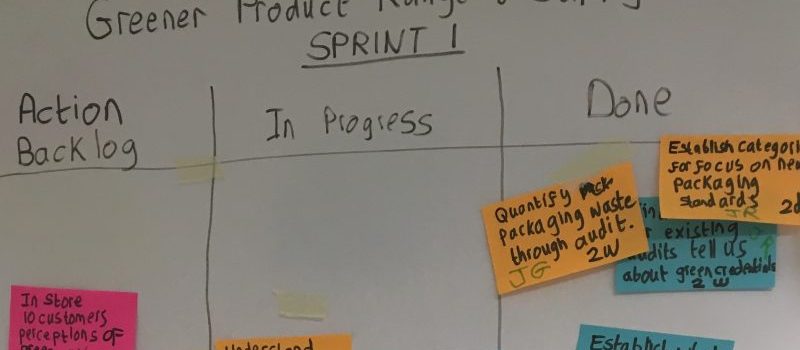The leader ambitiously wanted a “greener” business and it wasn’t clear how to get there.
Creative ideas were essential.
A cross-functional team would be needed.
red10 ‘s Sarah Barber and Tammy Watchorn share how they helped the team work it all out, in an agile way.
Design and Execution Workshop – In 3 Sprints:
We believed three agile principles would help the team to deliver the project.
- Gathering customer insight on their issues before starting the design process.
- Developing many prototypes to allow ideas to be tested before making major investment.
- Organising the work to be done into two-week sprints to allow for course corrections along the way and to make the project less overwhelming
Accordingly, we designed a workshop that guided the team through three 2-hour sprints: Insight, Prototyping and Execution. This meant that they could make a flying start on their greener project and learn about the agile principles as they went along. This approach to getting projects underway fast is described by Jake Knapp and his colleagues at Google Ventures in their book “Sprint”
Describing the goal
Before embarking on the first sprint, the team and the leader worked together to set the goal for the project.
This was expressed by describing the desired endpoint in the form “Wouldn’t it be nice if………..”. This statement (or WIBNI) became the standard against which ideas for action could be tested by asking how close they would bring the team to the goal.
SPRINT 1: Insight
The sprint began with researching the area and developing insights into what the goal meant in the minds of customers – both the end customers and the internal stakeholders who would be customers of the project.
Given the time constraints of a workshop, customers were described on written worksheets as “personas” including their characteristics and preferred means of communication. Team members then interviewed each other with one member taking the role of the described persona. This gave practice in asking open questions and gaining insight from the responses – which could be refined later by interviewing the customers themselves.
Using the research and the customer insights gained, the team developed ideas for action or for overcoming perceived obstacles expressed in the form “How might we………?” These ranged from:
“How might we switch to biodegradable packaging?”
To
“How might we reduce fuel use in supply and distribution?”
These were prioritised according to how close they might take the team to achieving the WIBNI statement and became the outputs of the first sprint.
Following a sprint review to capture any learning, the team were ready for a well-earned lunch.
Sprint 2: Prototyping
We introduced the LEGO® SERIOUS PLAY® (LSP) methodology to help develop creative ideas based on our “How might we” questions.
The method supports new thinking and is more about using the bricks as metaphors to represent features of the idea rather than building perfect representative models.
Following a short LSP introduction participants were tasked with building their ideas and responses to the high priority questions. Thinking was unconstrained – we even had a Lego® man kitesurfing to work! Soon the tables were covered with brightly coloured prototypes.
As team members started to describe what their models meant, they were able to cluster the prototypes into themes. Two strong themes emerged “Greener supply chain” and “Greener office”. It was time to get some customer feedback. Two team members agreed to take on the “personas” of an end customer and an office worker and give their reactions to the prototype descriptions. Prototypes were changed in response to feedback and we had some concrete starting points for the project.
After a quick sprint review, the team were ready to enter the “execution” sprint.
Sprint 3: Execution
The aim of this sprint was to build simple kanban boards for the first execution sprints of what had become the “Greener office” and “Greener supply chain” projects.
Once again, the customer “personas” were the starting point as the team asked themselves what features the customer would want to see in the prototypes modelled in Sprint 2. They then developed actions which would deliver those features with ‘guesstimates’ of how long each action might take to enable them to plan the first execution sprint.Sprints are used to break down big, complex projects into bite sized pieces that also result in outputs (features) being delivered from each sprint. Through time bounding sprints, teams can plan the actions for each sprint; deliver outputs regularly and make course corrections along the way. The team agreed that the execution sprints would be 2 weeks long – recognising that project work would need to be fitted in alongside the day job. So, the actions in each Sprint needed to be capable of completion within two weeks.
The first columns on the kanban boards were completed with a list of actions on sticky notes, colour coded according to the feature they would help to deliver and with the name of the responsible person attached. The boards were ready to go back to the office.

Over the next 2 weeks, team members would be moving actions across to the “in progress” and finally to the “done” column. They agreed to gather round the boards twice a week for a quick progress review meeting, known as a scrum.
After a sprint review, the workshop was complete. A summary of the three sprints can be found by following this link.

What happened next?
In just 1.5 days, the team had their project underway and the “greener business” goal was less overwhelming.
Three weeks later we had a message from the leader who contacted us “We are Kanbanning and Sprinting like mad men” and two months later concrete proposals were up for Board approval.
Do you have an ambitious project that you need to get underway fast?
Do you want to learn the Agile approach using a real project?
We’d love to help, just get in touch.

